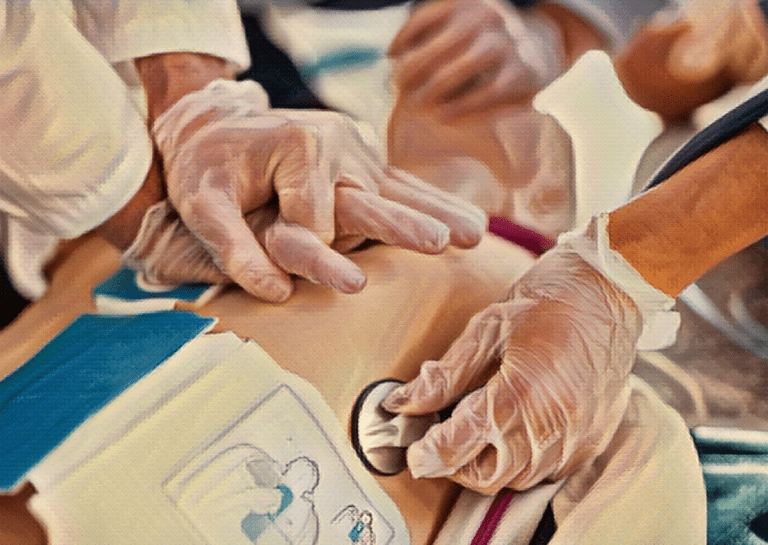AEDs (Automated External Defibrillators) are emergency devices used to deliver an electric shock to a victim of SCA (sudden cardiac arrest). The delivery of an electric shock is the most crucial intervention in instances of cardiac arrest. Early intervention can mean the difference between life and death.
The use of AEDs can significantly increase the victim’s chance of survival, which decreases by 5 to 10 percent with every passing minute before the electric shock is delivered. The likelihood of survival can double when an AED is administered by a lay first responder as opposed to emergency dispatch personnel who are not able to immediately intervene. This emphasizes the importance of early intervention and public education around the use of AEDs.
Table of contents
How does an AED work?
In some US states, AEDs are required in public and recreational areas such as schools, fitness centers, and workplaces. They should be easily visible and accessible for use by the general public in the case someone in the vicinity has a heart attack.
While the general appearance of AEDs can differ depending on the manufacturer, all AEDs will have the same essential components. AEDs typically consist of:
- An electrical box with an ON/OFF button or switch
- Self-adhesive electrode pads
- Connection cords
- A display screen for visual and/or audio instructions
- A shock button
An AED works by analyzing a person’s heart rhythms to determine whether or not there is a cardiac arrhythmia (irregular heart rhythm), and to instruct the user on how to proceed, i.e. if and when to deliver an electric shock.
AEDs can detect the presence of the two main arrhythmias responsible for cardiac arrest:
- Ventricular Tachycardia (VT — rapid heart rate of more than 100 beats per minute).
- Ventricular Fibrillation (VF — cessation of heartbeat and loss of pulse).
Once the AED has identified cardiac arrhythmia, it provides the user with the appropriate instructions to either administer an electric shock or continue Cardiopulmonary Resuscitation (CPR). This electric shock resets the heart’s rhythm and restores circulation. When administered early, this intervention can significantly improve the victim’s chances of survival after hospital admission.
Learning how to use an AED
AEDs are designed to be straightforward and accessible for use by members of the general public. Although any adult bystander can safely use an AED, it can be difficult to operate, particularly with the added stress and urgency of an emergency situation.
You can learn how to use an AED through in-person classes, instructional videos, or web-based tutorials. Emergency dispatchers can instruct lay bystanders on how to use an AED over the phone, but intervention is more effective when the user has prior knowledge or experience with operating an AED.
Using an AED
The following usage recommendations can help lay-first responders be more confident and efficient when assisting a victim of cardiac arrest.
Pad placement — The self-adhesive electrode pads should be placed with one on the right-hand side of the patient’s chest just below the collarbone, and the other on the lower left side underneath the armpit.
The pads should be placed directly onto the skin. Do not place the pads on top of a transdermal medication patch. Remove the medication patch and wipe the skin clean before applying the pad.
Chest hair can interfere with the electric-shock delivery and may need to be removed.
AED rescue kits often contain a razor to shave chest hair, but this can also be done by quickly removing a spare self-adhesive pad and thus pulling out enough hair to effectively administer an electric shock.
AED instructions — After analyzing the patient’s heart rhythms, the AED will provide prompts to the user which must be closely followed.
Neither the user nor any bystanders should touch the patient while this takes place.
The AED will identify either a shockable or non-shockable rhythm. In the case of the latter, the AED will prompt the user to resume CPR and the device will reassess the heart rhythm in 2-minute intervals.
If a shockable rhythm is identified, the AED will charge itself and the user will be prompted to press the shock button.
References
- Harve H, Jokela J, Tissari A, Saukko A, Räsänen P, Okkolin T, Pettilä V, Silfvast T. Can untrained laypersons use a defibrillator with dispatcher assistance? Acad Emerg Med. 2007 Jul;14(7):624-8. doi: 10.1197/j.aem.2007.03.1353. Epub 2007 May 31. PMID: 17541030.
- Weaver WD, Hill D, Fahrenbruch CE, Copass MK, Martin JS, Cobb LA, Hallstrom AP. Use of the automatic external defibrillator in the management of out-of-hospital cardiac arrest. N Engl J Med. 1988 Sep 15;319(11):661-6. doi:10.1056/NEJM198809153191101. PMID: 3412383.
- Zheng ZJ, Croft JB, Giles WH, Mensah GA. Sudden cardiac death in the United States, 1989 to 1998. Circulation. 2001 Oct 30;104(18):2158-63. doi: 10.1161/hc4301.098254. PMID: 11684624.
